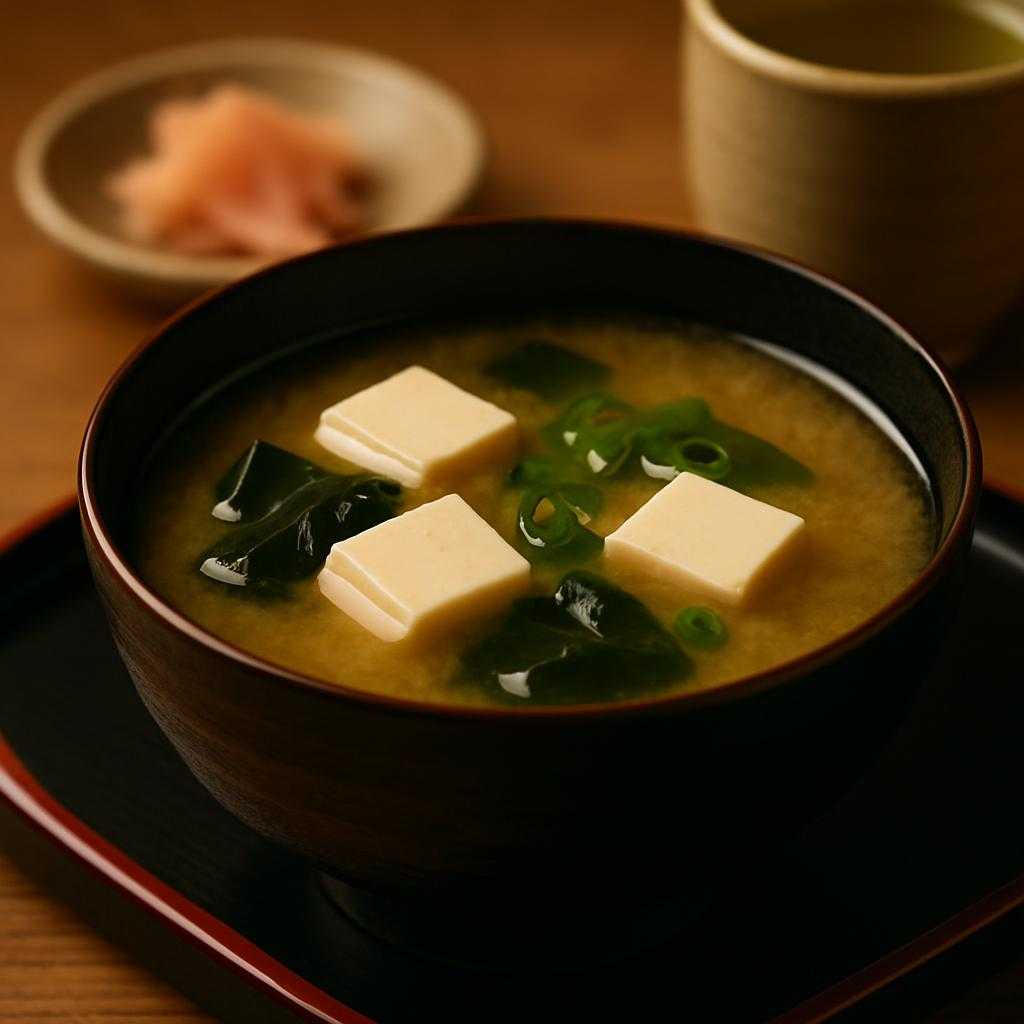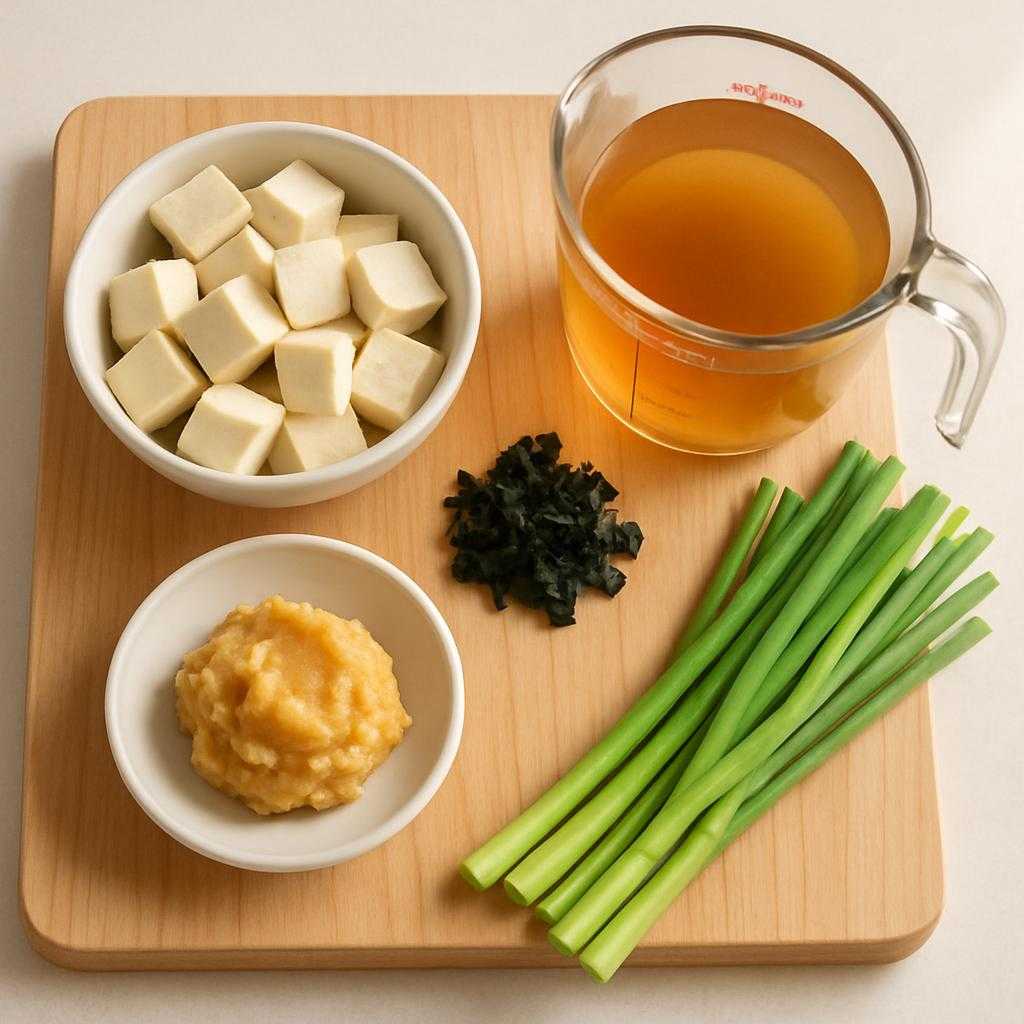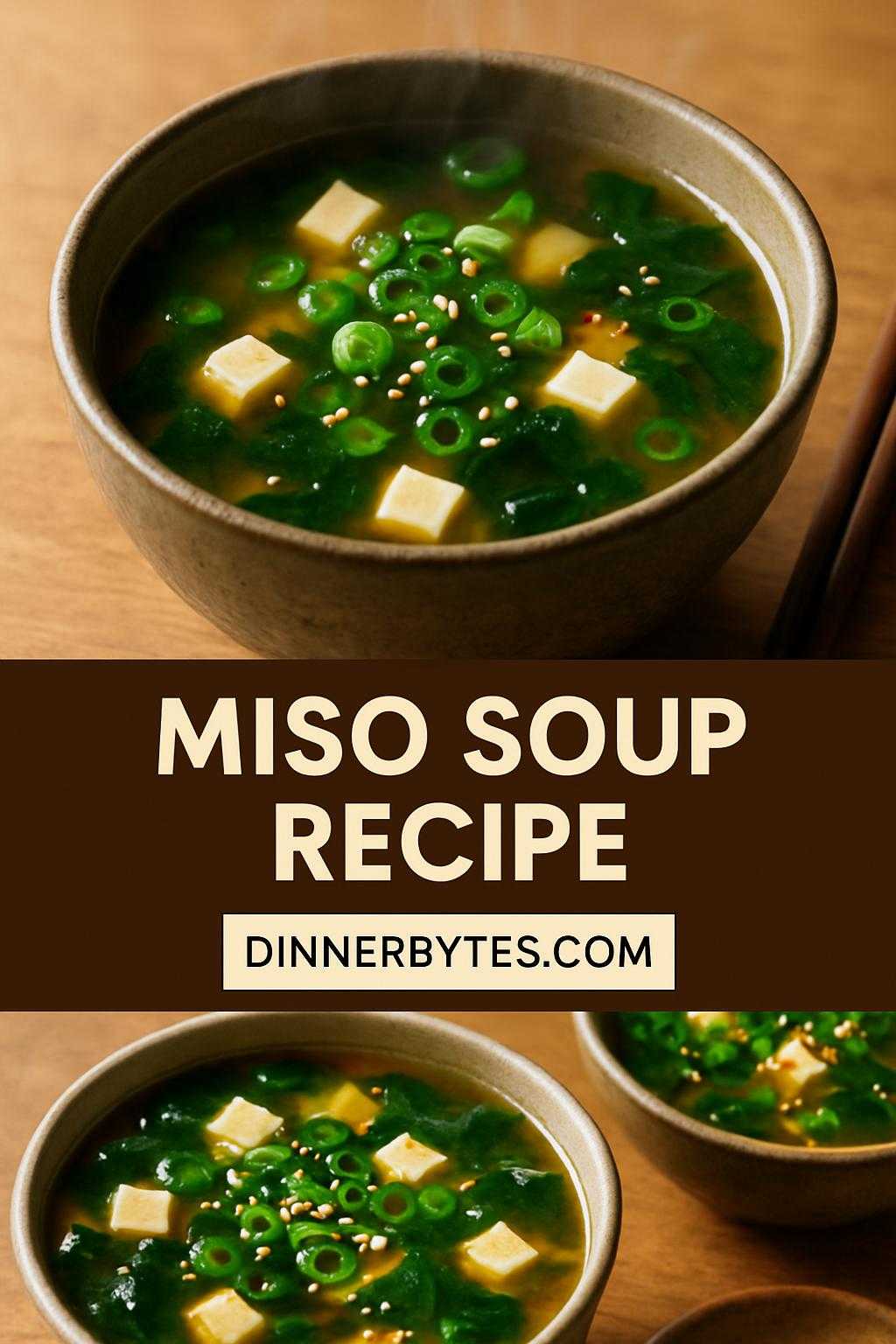Miso Soup is a classic Japanese comfort food that brings warmth and umami-rich flavor to any meal. This simple yet deeply satisfying soup features a savory broth made from miso paste and dashi, combined with tender tofu cubes, seaweed, and fresh scallions. Its light but flavorful profile makes it a perfect starter or a soothing snack any time of the day.

Why You Will Love This Recipe
You’ll love this miso soup recipe because it is incredibly quick to prepare and packed with complex, savory flavors despite its minimal ingredients. The delicate balance of salty miso and the subtle oceanic notes from seaweed creates a comforting broth that’s also nutritious and light. It’s perfect for those following a vegetarian or pescatarian diet and easily adaptable to vegan lifestyles. Plus, it requires just a few pantry staples and minimal cooking skills, making it accessible for cooks of all levels.
Tips and Tricks
- Use good quality miso paste (white or yellow miso for a milder flavor, red miso for a stronger taste) to enhance the broth’s depth.
- Dissolve the miso paste in a small amount of warm dashi stock before adding it to the pot to ensure smooth mixing without clumps.
- Avoid boiling the soup after adding miso paste; heat gently to preserve its flavor and probiotics.
- Soak dried wakame seaweed briefly before adding to rehydrate and soften.
- Cut tofu into small cubes to allow even heating and easy spoonfuls.
- Add scallions last for a fresh, crunchy contrast.
Make Ahead Tips
You can prepare the dashi stock a day or two in advance and keep it refrigerated. Tofu can be pre-cut and stored in a sealed container. Dried wakame seaweed can be pre-soaked and kept in water in the fridge for up to 24 hours. Miso paste should be added just before serving to maintain its flavor and nutritional qualities.

Recipe Variations
- Swap tofu for thinly sliced mushrooms like shiitake or enoki for a heartier soup.
- Add thinly sliced daikon radish or carrots for extra texture and sweetness.
- Use different types of miso paste to vary flavor intensity.
- Incorporate noodles such as soba or udon to make the soup more filling.
- Add a soft boiled egg or some cooked seafood like shrimp for non-vegetarian versions.
How to Serve
Serve miso soup hot in small bowls, garnished with fresh scallion rings and a sprinkle of toasted sesame seeds or shichimi togarashi (Japanese seven-spice) for a flavor kick. It pairs beautifully alongside sushi, rice bowls, or as a soothing starter for any Japanese meal.

Pairing Suggestions
Pair miso soup with a chilled glass of sake or green tea for a traditional experience. For a non-alcoholic option, jasmine tea complements the soup’s umami notes. Light side dishes like steamed rice, pickled vegetables, or tempura make excellent companions. Finish the meal with a light dessert like mochi or fresh fruit.
How to Store
Store leftover miso soup in an airtight container in the refrigerator for up to 2 days. Avoid freezing as miso’s flavor and texture may be compromised. To reheat, warm gently on the stove over low heat without boiling, to preserve the delicate flavors.
Equipment Needed
- Medium saucepan or pot
- Ladle
- Small bowl for dissolving miso
- Measuring spoons
- Knife and cutting board
Alternatives: For dashi, you can use instant dashi powder and a kettle for hot water if you don’t want to make stock from scratch.

Dietary Adaptations
- Vegan: Use kombu and shiitake mushroom dashi instead of fish-based dashi.
- Gluten-free: Choose gluten-free miso paste (some contain barley or wheat).
- Soy-free: Use chickpea or other legume-based miso alternatives and substitute tofu with firm cooked vegetables.
- Nut-free: This recipe is naturally nut-free but always check labels for cross-contamination.
Seasonal Adaptations
In spring and summer, add fresh seasonal vegetables like snap peas or baby spinach to the soup for brightness. In winter, incorporate root vegetables such as daikon or carrots for heartiness. Switch from dried to fresh wakame if available for a more vibrant texture.
Recipe FAQs
Q: Can I use chicken broth instead of dashi?
A: While chicken broth can be used, it changes the traditional flavor profile. Dashi provides a specific umami taste essential to authentic miso soup.
Q: How long does miso soup take to cook?
A: About 10-15 minutes total, including preparing the broth and adding ingredients.
Q: Can I store miso soup with tofu overnight?
A: Yes, but tofu may absorb more broth and become softer. Store separately if possible.
Q: How much miso paste should I add per serving?
A: Generally 1 tablespoon of miso paste per 2 cups of broth works well.
How To Make miso soup recipe
Miso Soup

Miso Soup is a classic Japanese comfort food that brings warmth and umami-rich flavor to any meal.
Ingredients
- 4 cups dashi stock (homemade or instant)
- 3 tablespoons white or yellow miso paste
- 1/2 cup firm tofu, diced into small cubes
- 1 tablespoon dried wakame seaweed
- 2 scallions, thinly sliced
- Optional: toasted sesame seeds or shichimi togarashi for garnish
Instructions
- Prepare dashi stock by simmering kombu and bonito flakes, or dissolve instant dashi powder in hot water according to package instructions. Keep warm.
- Soak dried wakame seaweed in cold water for 5 minutes until rehydrated. Drain and set aside.
- In a medium saucepan, gently heat the dashi stock over medium heat until hot but not boiling.
- Place miso paste in a small bowl and add a ladleful of warm dashi stock. Whisk until smooth and no lumps remain.
- Slowly stir the dissolved miso back into the pot. Reduce the heat to low—do not boil.
- Add the diced tofu and rehydrated wakame into the soup. Warm for 2-3 minutes until heated through.
- Remove from heat and ladle into bowls. Top with sliced scallions and optional garnishes. Serve immediately.
Nutrition Information
Yield
4Serving Size
1Amount Per Serving Calories 114Total Fat 7gSaturated Fat 1gTrans Fat 0gUnsaturated Fat 5gCholesterol 2mgSodium 537mgCarbohydrates 4gFiber 2gSugar 1gProtein 10g
dinnerbytes.com, occasionally offers nutritional information for recipes contained on this site. This information is provided as a courtesy and is an estimate only. This information comes from online calculators. Although dinnerbytes.com attempts to provide accurate nutritional information, these figures are only estimates.
Final Thoughts
Making miso soup at home is a rewarding experience that brings a little taste of Japan to your kitchen with minimal effort. By following this recipe, you’ll enjoy a rich, umami-laden broth complemented by silky tofu and briny seaweed that’s both nourishing and comforting. Experiment with variations and garnishes to find your perfect bowl, and savor the simple elegance of this timeless soup whenever you need a quick, healthy pick-me-up.







